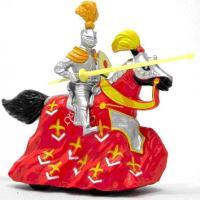
Equestrian Dominance
I would like to talk about a case when two knights are stronger than two bishops. The obvious case is when the position is closed – there are no open diagonals for the bishops and many outposts for the knights. This article addresses the other case when two knights participate in preparation for attack. It is well known that tandem queen with knight is very dangerous. It is especially the case in attack. When facing the attack two bishops are usually of no help and it is better to trade them for the knights. Of course, for the side with two bishops opening the position is almost always the right thing to do. The side with the knights prefers to have diagonals closed so the bishops would stay locked behind a pawn chain.
Black temporarily is up a pawn but white can get it back with N:c6. If you look at the position carefully you can notice that the black pieces are horribly misplaced while the white pieces are well coordinated. Qa3 and Rb8 cooperate by controlling the b-file; one can call Na6 a helpful piece too: it can be transferred to d5. Bh6 controls the important c1 square but It would be better off on g7 protecting the king and not being loose. Bc8 and Rf8 are not developed yet. White's knights get outposts on c5 and e5 due to the isolated d4 pawn. White's pieces are also more compact. Here white has the tempting possibility of N:c6 or the continuation that they chose in the game.
While the previous example showed how queen and knight cooperate in attack, the next one shows the combination queen and bishop in attack vs. a knight in defense. With the last move black had offered the exchange of his light-squared bishop. This is a very logical decision, considering black’s blockade of the position on light squares, having most of the pawns on the light squares. White has a choice of keeping two bishops or exchanging Bc2. White makes the correct decision of keeping two bishops, if the position opens up the bishops would be powerful and until then it does not seem black has much play with his knights.
Let’s take a look at another example where the white knights dominate the bishops. In the following position the knights and the queen plus two pawns are about to create a dangerous attack on the black king. The sad story for black is that they don’t have play. White has more pawns on the kingside, due to the doubled c-pawns. Ng5 is greatly placed on g5, h5 is a threat already. Black needs immediately to open the position on the kingside with maybe b5-c4.
The next position features ideas similar to what we have seen so far. White castled long, while black castled short. White's king is seriously weakened by the a3 move and by the missing c4 pawn. Ideally, black would want to put his knight on d5 but there are too many white pieces that are controlling this square. White would like to trade his dark-squared bishop, since it is blocked behind the e3 pawn, unless he manages to push e4 to activate it. C5 break is a logical move here but there is a better solution.
As you can see, two knights can be a great power, especially in attack. Landing your knight on f7 as in example three guarantees the win. A side with two bishops sometimes sticks to this advantage paying a price of worsening his position. As shown in example four giving up a bishop for the knight, especially if it is an attacking knights can be a correct solution. Overall, one should look at a position with a fresh perspective, stereotypes such as two bishops are always stronger than two knights do not work In a practical game.



